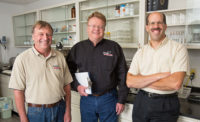Biosecurity Begins on the Live Side

The times, they are not a-changin’ — they’d changed long ago in the realm of food safety and security.as such, any processors, packers or producers who have not embraced the idea that their supply chain is vulnerable are putting their product in serious danger of anchoring all the wrong kinds of headlines.
Processors can keep their facilities secure and outfit their products with anti-tampering indicators to keep consumers safe, but biosecurity starts on the farm, and for producers, there are many resources available at the university level to help them maintain a secure herd or flock.

|
When most people think of the word “biosecurity,” they might think it means keeping the food supply safe from intentional efforts to contaminate the system by terrorists or criminals. However, the meaning goes beyond that for researchers at cattle operations.
Consider the following description of “biosecurity” as introduced in a University of Nebraska-Lincoln (UNL) Extension NebGuide fact sheet, titled “Biosecurity Basics for Cattle Operations and Good Management Practices (GMP) for Controlling Infectious Diseases”:
“The goal of biosecurity is to stop transmission of disease causing agents by preventing, minimizing or controlling cross-contamination of body fluids (feces, urine, saliva, etc.) between animals, animals to feed and animals to equipment that may directly or indirectly contact animals.”1
In this description, intent doesn’t matter to researchers, and it shouldn’t matter to operators either. Regardless of the source, businesses need to enact a plan of identification and prevention in order to ensure a secure and safe herd, and consequently, a safe food supply. The UNL researchers admit that development and maintenance of a biosecurity program is difficult, but it remains “the cheapest, most effective means of disease control available.”
The team advises operators to develop a biosecurity resource group at each facility, an idea that shouldn’t be unfamiliar to many processors who have dedicated food-safety or worker-safety teams within the walls of each facility. This group would theoretically consist of biosecurity champions who take ownership of the standards, strategies and practices at the facility.
Operators who focus their efforts on managing the introduction of new cattle into the herd and traffic control in the facility have hit on the key priorities, the UNL fact sheet states. Further, isolation of cattle, traffic control into and around the facility — vehicular, human and animal — and sanitation are the three major components of biosecurity that operators must monitor and manage.
For operators who can keep these aspects of their facilities under control, biosecurity becomes less of a difficult task as efficiency, quality and safety improves for the animals, consumers and workers at the facility.
For more information on a variety of topics of interest to the protein industry, visit the UNL Extension’s Web site at www.ianrpubs.unl.edu.
Endnotes
1Buhman, M., Dewell, G., Griffin, D.; “Biosecurity Basics for Cattle Operations and Good Management Practices (GMP) for Controlling Infectious Diseases”; University of Nebraska-Lincoln Extension, http://www.ianrpubs.unl.edu/epublic/pages/index.jsp.
Looking for a reprint of this article?
From high-res PDFs to custom plaques, order your copy today!








